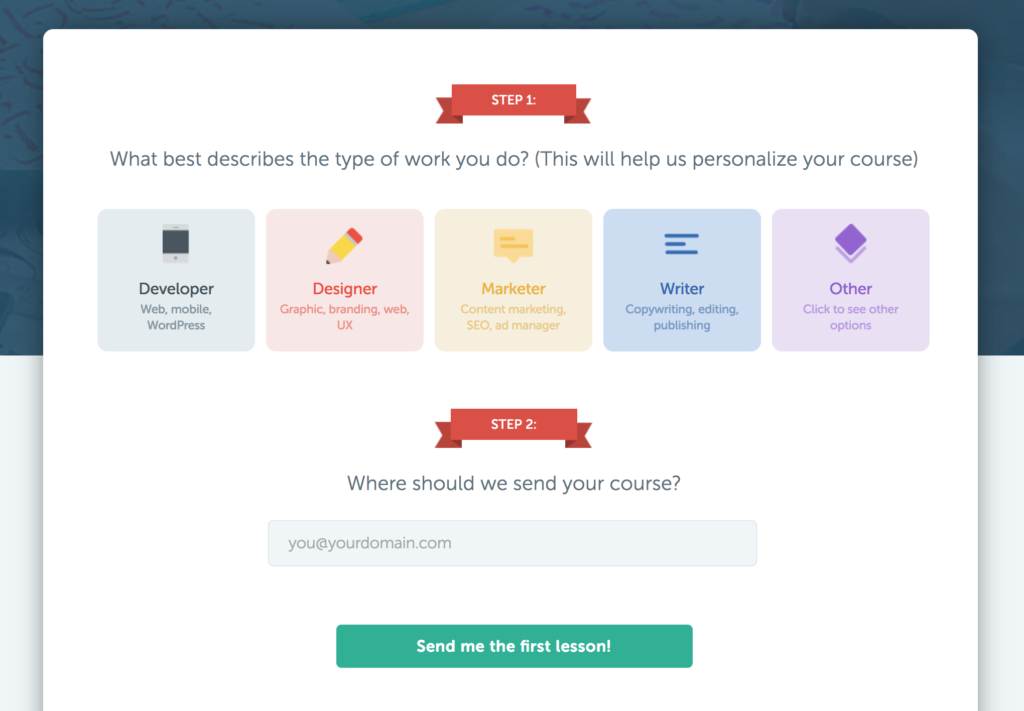94% of marketers agree that “personalizing the web experience” is critical to current and future success.
So ~94% of marketers are gonna be taking advantage of personalization, right?
Nearly.
4%.
4%.
FOUR PERCENT of marketers reckon they’re doing a lot of personalization, despite 94% saying it’s critical.
Ouch.

By far the most common reason companies aren’t reaping the incredible rewards of personalization?
They don’t know how to do it - or where to start.
Which is understandable. There’s so much potential that it can be totally overwhelming. It’s easier to work on… other stuff.
So what is personalization? Where do you start?
This article is an attempt to answer those questions.
If you have any questions about personalization-about how to go from where you are now to a place where your subscribers are happier and your conversion rates are through the roof (which is a super happy place to be), please just tweet/email me and ask. I am so happy to help out with this stuff.
What is personalization?
Personalization just means showing different marketing messaging to different people - based on what you know about them.
In a one-to-one (sales) conversation, you’d say different things to your conversation partner based on what you know about them; where they’re trying to get to; and so on. Personalization is all about doing that same thing, but at scale.
It’s useful to think of this as three distinct stages. You’ll want to have these three things in place to succeed with personalization:
Stage 1: Find out stuff about your website visitors / customers
Buy binoculars.
Collecting data (or “profiling”) is the cornerstone of personalization. If you don’t know anything about a web site visitor, you can’t personalize their experience to suit.
There are a million ways to gather this data, but they fall into two broad categories - active and passive:
Active profiling
This is where you explicitly ask a user for data about himself/herself.
While blindly asking them for every detail about them probably isn’t so smart, there are ways to effectively achieve this:
- Popping up a one-question-at-a-time survey at specific points in their journey on your web site (might be when they get a significant way through reading an article). This has a much higher response rate than emailing customers asking them to fill in a survey - people are surprisingly willing to answer a simple question optionally placed in front of them.
- Asking for information that’s relevant to whatever you’re about to deliver them. This is even better than the 1-question survey, because (a) it’s non-optional, but (b) there’s a clear and valid reason why you’re asking. Brennan Dunn of Double Your Freelancing does a fantastic job of this at opt-in to his Charge What You’re Worth course:

He’s asking the question so he can personalize the course content (see Stage #3 below) - but he’s also recording that information in his subscriber database forevermore.
Passive profiling
This is where you’re able to gather data about your visitors / subscribers / customers without even asking them. Examples include:
- Tracking which articles they’ve read
- (and keeping a running total of which category of article they’re leaning toward most strongly)
- Tracking which products or services they’ve bought from you
- Tracking where they arrived at your site from (especially if it was from a campaign/podcast appearance/etc etc targeted at one specific segment)
Get all that data recorded in your ESP / marketing automation software (Drip, ActiveCampaign, Klaviyo, etc) and you’re good to go.
Stage 2: Analyse the data from Stage 1
You can use the insight you gain from the data in Stage 1 to help you make better decisions.
How many of your subscribers fall into one segment vs another ?
Which kind of people are most likely to buy which product?1
How much is a subscriber worth? Which of your segments makes for the most valuable subscribers (i.e. which of your segments buys the most from you)? → This one’s huge, cos it’ll let you:
- Double down and target paid ads, podcast appearances, whatever, that cater exclusively to that segment
- Know you’re getting a positive ROI whenever you do any paid acquisition
Stage 3: Feed that individualized data back into your marketing
This is where the real magic happens.
If the person looking at your web site right now is a professional chef, they should see marketing that talks about them as a professional chef. They should see testimonials from other professional chefs. ^^ I HAVE SEEN THIS TACTIC ALONE MORE THAN DOUBLE FREE-TO-PAID CONVERSIONS OVERNIGHT.
If the person looking at your web site is already on your email list and has bought all of your products except your premium coaching, you should not have a generic email opt-in form at the bottom of your blog articles when they read them. That generic opt-in should be swapped out for a promotion for your premium coaching.
If you release a product that will only suit a certain segment/demographic, you can target Facebook ads for that new product to people who have visited your web site / opted in to your list who fit the demographic/segment you want to target the product to.
You can send broadcast emails to people in a given segment, or people who have (or haven’t) bought a given product.
You can set the P.S. at the bottom of all your emails to change dynamically for each recipient, offering them whichever product you want them to buy next based on where they are in your funnel.
You can email customers half an hour after they read your sales page but didn’t buy from you-to ask what was lacking for them-while it’s still top of their mind.
You really are only limited by your imagination here.
Summing up
I hope this article has given you a taste of what’s possible and how personalization can be applied to make a significant difference to your conversion rates (→ your bottom line).
I know this was more high level than actionable - I’ve laid out all the principles, but not told you step by step how to start implementing them. But I’m more than happy to do so. I just need to know what you need to know.
Tweet or email me and let me know what you’d like to read about next (more examples of personalization in action? Or a guide to how to physically start tracking that data? Or have you got some of this implemented but are stuck on a specific step? Something else?) Tweet me.
-
You can actually use this data in two totally opposite ways. If one of your segments is “professional chefs”, and you discover that professional chefs keep buying Product X as their first product, you can either decide “hey, let’s double down and heavily promote Product X to professional chefs when they sign up”, or “why aren’t the other segments buying so much of Product X? Could we nudge them to buy it more?” ↩
